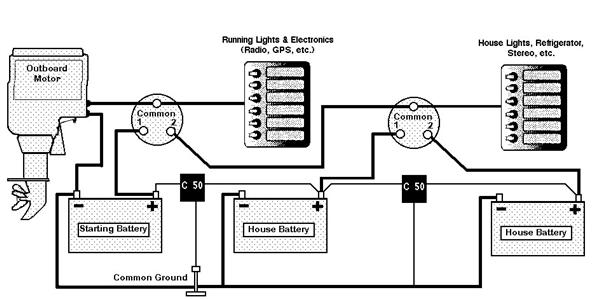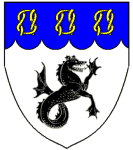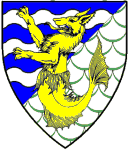| View previous topic :: View next topic |
| Author |
Message |
JGrider
Joined: 26 Feb 2010
Posts: 93
City/Region: Laplace
State or Province: LA
C-Dory Year: 2006
C-Dory Model: 22 Cruiser
Vessel Name: Jeannie's VOO DOO
Photos: Jeannie’s VOO DOO
|
 Posted: Mon Oct 17, 2011 12:51 am Post subject: Third battery Diagram Posted: Mon Oct 17, 2011 12:51 am Post subject: Third battery Diagram |
 |
|
I am trying to get some feedback before I blow up my batteries.
The only sketch I found that looks like what I am trying to do I found in the first picture under electrical pictures. I have two four position battery switches but in all the reading I have done I do not read anywhere where anyone is using this setup. I do not have the buss panel shown on the right but everything else looks like what I have. What do you think the little black boxes with the 50 in them is? Is this a charger?
I have just installed a xantrex 2 three bank charger an I am a little afraid to turn on the switch.
http://www.c-brats.com/albums/ElectricalandWiring/Alternative_three_battery_setup.thumb.jpg
_________________
John & Jeannie Grider
Jeannie's VooDoo
Home port: LaPlace, Louisiana |
|
| Back to top |
|
 |
Sea Wolf
Joined: 01 Nov 2003
Posts: 8650
City/Region: Redding
State or Province: CA
C-Dory Year: 1987
C-Dory Model: 22 Cruiser
Vessel Name: Sea Wolf
Photos: Sea Wolf
|
 Posted: Mon Oct 17, 2011 5:46 am Post subject: Posted: Mon Oct 17, 2011 5:46 am Post subject: |
 |
|
Let's make that diagram a little larger:

And a LINK to the diagram itself with some discussion.
Looks like it would work to isolate the starting battery from the house bank, but also allow one to use the house bank for starting.
The two C50 (s) is probably a two bank 5.0 amp charger.
Joe.  
_________________
Sea Wolf, C-Brat #31
Lake Shasta, California
  
"Most of my money I spent on boats and women. The rest I squandered'. " -Annonymous |
|
| Back to top |
|
 |
JGrider
Joined: 26 Feb 2010
Posts: 93
City/Region: Laplace
State or Province: LA
C-Dory Year: 2006
C-Dory Model: 22 Cruiser
Vessel Name: Jeannie's VOO DOO
Photos: Jeannie’s VOO DOO
|
 Posted: Mon Oct 17, 2011 10:47 am Post subject: Third battery Diagram Posted: Mon Oct 17, 2011 10:47 am Post subject: Third battery Diagram |
 |
|
| Thanks for making it larger. I tried without success to paste this in the post. I guess I am wondering why people use so many electronic components when this is so simple and appears to work as long as you don't mind switching manually. |
|
| Back to top |
|
 |
Sea Wolf
Joined: 01 Nov 2003
Posts: 8650
City/Region: Redding
State or Province: CA
C-Dory Year: 1987
C-Dory Model: 22 Cruiser
Vessel Name: Sea Wolf
Photos: Sea Wolf
|
 Posted: Mon Oct 17, 2011 11:34 am Post subject: Re: Third battery Diagram Posted: Mon Oct 17, 2011 11:34 am Post subject: Re: Third battery Diagram |
 |
|
| JGrider wrote: | | Thanks for making it larger. I tried without success to paste this in the post. I guess I am wondering why people use so many electronic components when this is so simple and appears to work as long as you don't mind switching manually. |
Good point! I prefer the KISS principle too! 
Joe.   |
|
| Back to top |
|
 |
Matt Gurnsey
Dealer
Joined: 11 Nov 2008
Posts: 1532
City/Region: Port Orchard
State or Province: WA
Photos: Kitsap Marina
|
 Posted: Mon Oct 17, 2011 12:24 pm Post subject: Posted: Mon Oct 17, 2011 12:24 pm Post subject: |
 |
|
The problem I see here is that teh engine is not charging the house batteries unless both switches are on both.
If the point is isolation of the house batteries, one must throw the first switch to 1 or "off" after running the engine. Then if one forgets to throw the switch you could run all day, and not charge the house bank.
Now, if switch one were replaced with this:
http://bluesea.com/products/7650

the batteries would be isolated, but would be charged anytime the engine is running, as well as have the ability to bridge the house batteries with the starting battery should an accidental discharge require it.
Without this system, you might also run into issues when charging because of the disimilar battery bank sizes.
I guess it's all in how you look at it, bit I find the two switch set-up more complex and prone to incorrect setting. But that's just me.
_________________
Matt Gurnsey
Kitsap Marina
www.kitsapmarina.com
360-895-2193
(888) 293-7991 |
|
| Back to top |
|
 |
tpbrady
Joined: 08 Feb 2005
Posts: 891
City/Region: Anchorage
State or Province: AK
C-Dory Year: 2005
C-Dory Model: 25 Cruiser
Vessel Name: Bidarka II
Photos: Bidarka
|
 Posted: Mon Oct 17, 2011 12:40 pm Post subject: Posted: Mon Oct 17, 2011 12:40 pm Post subject: |
 |
|
Matt,
That's what I use. However, I think you could use an ACR in the first setup to do the same thing.
_________________
Tom
22 Cruiser Bidarka 2004-2009
25 Cruiser Bidarka II 2010-2013
38 Trawler Mia Terra 2012-2015
42 Nordic Tug 2015-
28 KingFisher 2009-2014
14 Jetcraft 2000-
17 Scanoe 1981- |
|
| Back to top |
|
 |
JGrider
Joined: 26 Feb 2010
Posts: 93
City/Region: Laplace
State or Province: LA
C-Dory Year: 2006
C-Dory Model: 22 Cruiser
Vessel Name: Jeannie's VOO DOO
Photos: Jeannie’s VOO DOO
|
 Posted: Mon Oct 17, 2011 4:23 pm Post subject: Third battery Diagram Posted: Mon Oct 17, 2011 4:23 pm Post subject: Third battery Diagram |
 |
|
| Thanks Matt, That is sort of my problem. I do not fully understand the operation of the switch that you recommended. I will gladly take your advice. I would like to know how you would normally run with the switch you recommend and when I install it which switch should I replace. The one in the diagram nearest the motor? |
|
| Back to top |
|
 |
Matt Gurnsey
Dealer
Joined: 11 Nov 2008
Posts: 1532
City/Region: Port Orchard
State or Province: WA
Photos: Kitsap Marina
|
 Posted: Mon Oct 17, 2011 6:00 pm Post subject: Posted: Mon Oct 17, 2011 6:00 pm Post subject: |
 |
|
My thought would be the switch nearest the motor should have the Blue Seas unit. It has an Off/On/Emergency switch.
Basically, when on, the engine can charge both battery banks, but they remain isolated from each other. The black box determines where the engine's charging voltage goes- first to the starting battery to top it off, and then to the house battery bank.
When the key is turned off, and no charge voltage is present, the battery banks are isolated.
Should the starting battery becoem discharged, moving the switch to Emergency Start brings the house bank online so you can start the engine.
I like this unit because it's one less switch to worry about. Turn it on when you get aboard the boat, and leave it alone until you're done with your journey. |
|
| Back to top |
|
 |
thataway
Joined: 02 Nov 2003
Posts: 21357
City/Region: Pensacola
State or Province: FL
C-Dory Year: 2007
C-Dory Model: 25 Cruiser
Vessel Name: thataway
Photos: Thataway
|
 Posted: Mon Oct 17, 2011 8:32 pm Post subject: Posted: Mon Oct 17, 2011 8:32 pm Post subject: |
 |
|
I may confuse the issue, and don't know where that diagram came from, but it is not the way I set up a boat. You do NOT want the electronics and running lights running off the engine start battery, which is basically "hard wired" (by being on the output or common of switch #1) to the engine start and charging system. There are two reasons: 1. is that you do not want to have the electronics on the battery when you start the engine--the voltage will drop, and as the alternator kicks in, there may be voltage spikes--so both of these are bad. Also leaving these, and any running lights on, may drain the starting battery.
Why not combine the two identical house batteries, in one bank--the single start battery in an other bank? The house then are connoted to the alternator output by a combiner (or what Matt describes--which I believe is just another form of combiner). The Voltage sensitive relay or combiner leaves the battery banks isolated when the voltage is less than 12. 7 volts. When the engine starts, and voltage is up to 13.4 volts, as the starting battery has started to charge, all three batteries are combined, and charged. As you stop the engine, and the battery voltage drops to less than 12.7 volts, then the batteries are isolated. This has nothing to do with the "key" --as Matt eludes to--and that may be a function of the product he depicted. (There are ways that combiners can be controlled with various switches). You can still use the two battery switches which you have, and just add a combiner or VSR. This ends up with a "fool proof" system, and no switches to throw under normal circumstances. (The "both" of the current switch will combine the two house batteries, and you can keep that if you wish).
_________________
Bob Austin
Thataway
Thataway (Ex Seaweed) 2007 25 C Dory May 2018 to Oct. 2021
Thisaway 2006 22' CDory November 2011 to May 2018
Caracal 18 140 Suzuki 2007 to present
Thataway TomCat 255 150 Suzukis June 2006 thru August 2011
C Pelican; 1992, 22 Cruiser, 2002 thru 2006
Frequent Sea; 2003 C D 25, 2007 thru 2009
KA6PKB
Home port: Pensacola FL |
|
| Back to top |
|
 |
localboy
Joined: 30 Sep 2006
Posts: 4673
City/Region: Lake Stevens via Honolulu
State or Province: WA
C-Dory Year: 2007
C-Dory Model: 25 Cruiser
Vessel Name: 'Au Kai (Ocean Traveler)
Photos: 'AU KAI
|
 Posted: Mon Oct 17, 2011 8:34 pm Post subject: Posted: Mon Oct 17, 2011 8:34 pm Post subject: |
 |
|
| Matt Gurnsey wrote: | Basically, when on, the engine can charge both battery banks, but they remain isolated from each other. The black box determines where the engine's charging voltage goes- first to the starting battery to top it off, and then to the house battery bank.
When the key is turned off, and no charge voltage is present, the battery banks are isolated.
Should the starting battery becoem discharged, moving the switch to Emergency Start brings the house bank online so you can start the engine.
I like this unit because it's one less switch to worry about. Turn it on when you get aboard the boat, and leave it alone until you're done with your journey. |
A couple of months ago I posted a question as to the benefit(s) of using the Blue Sea switch you posted. Some of us are not electrical savants. I think I will install one now that you've "dumbed it down" for me. 
_________________
"We can go over there...behind the 'little one'....."
Wife to her husband pointing @ us...from the bow of their 50-footer; Prideaux Haven 2013 |
|
| Back to top |
|
 |
petemos
Joined: 22 Mar 2008
Posts: 162
State or Province: NS
C-Dory Year: 2007
C-Dory Model: 22 Cruiser
Vessel Name: C-You-Later
Photos: C-You-Later
|
 Posted: Tue Oct 18, 2011 9:43 am Post subject: Posted: Tue Oct 18, 2011 9:43 am Post subject: |
 |
|
I guess I have somewhat the same question. I would like to install a (3) dedicated house battery, as today I just have two batteries that can both function as a start/house depending on the switch setting. I have installed a dual ARC for the two batteries with an integrated into the switch.
My question is, how do a separate the house wiring from everything else? I don’t recall, but should there be two positives off the common on the battery switch? One for the Engine and one for the Home run back to the main power block in the cabin. If so, then I would probably still need a second switch to be able to isolate/combine the house with the start batteries, correct?
Thanks Jim |
|
| Back to top |
|
 |
Matt Gurnsey
Dealer
Joined: 11 Nov 2008
Posts: 1532
City/Region: Port Orchard
State or Province: WA
Photos: Kitsap Marina
|
 Posted: Tue Oct 18, 2011 2:07 pm Post subject: Posted: Tue Oct 18, 2011 2:07 pm Post subject: |
 |
|
To clarify, I mentioned the "key off" as shutting the engine off. The ACR sense voltage as Bob mentions. Turning the key off, shuts off the engine, and it's charging system, which drops the voltage to trigger the isolation of the batteries. The key really has nothing to do with the operation.
And I agree, I would probably eleiminate the second switch, as it creates the issue where if set to 1 or 2 would allow only one house battery to be charged. Best to use both batteries as a bank.
And Mark, I'm happy to "dumb down" any other issues you may be having...  |
|
| Back to top |
|
 |
thataway
Joined: 02 Nov 2003
Posts: 21357
City/Region: Pensacola
State or Province: FL
C-Dory Year: 2007
C-Dory Model: 25 Cruiser
Vessel Name: thataway
Photos: Thataway
|
 Posted: Tue Oct 18, 2011 9:06 pm Post subject: Posted: Tue Oct 18, 2011 9:06 pm Post subject: |
 |
|
Jim,
Generally the best practice is a bus bar near the batteries. All of the house items (includes all electronics, lights, refer etc) run off the bus. I like to have a "on/off" switch between the battery and the bus--to eliminate any potential drain on the battery when I leave the boat. (such as memory of a stereo or chart plotter etc). The bilge pump is often directly wired to the house battery as a safety issue.
The 1/2/both/off switch will allow you to change an engine start to the engine battery or the "house" bank of two batteries. The combiner will charge both the start battery and the two batteries which are the house bank. |
|
| Back to top |
|
 |
petemos
Joined: 22 Mar 2008
Posts: 162
State or Province: NS
C-Dory Year: 2007
C-Dory Model: 22 Cruiser
Vessel Name: C-You-Later
Photos: C-You-Later
|
 Posted: Thu Oct 20, 2011 1:18 pm Post subject: Posted: Thu Oct 20, 2011 1:18 pm Post subject: |
 |
|
Hi and thanks for the bus bar idea. As I don’t have access to my boat right now, I’ll have to check whether there is one currently for the Positive legs. I know there is one for the negative legs. Based on your comments, and not having chart software, let me see if I have it right.
1. Everything on the boat, except the engine, should be connected to a Positive Bus bar.
2. Next there is a switch between the Positive Bus bar and the House battery banks. The bilge pump also connects directly to the House battery banks.
3. The (second switch) “main switch’s” Positive common connects to the engine.
4. The selector 1 on the “main switch” goes to the Starter battery
5. The selector 2 on the “main switch” goes to the House battery bank.
6. The dual VSR (when the selector switch is in 1) will charge the starter battery first, then the house batteries one the starter battery is topped off.
7. My 20 amp charger, which has 3 legs, connects directly to the house batteries and the starter battery.
That seems to the process, based on my understand. Let me know if you think I missed anything.
Thanks Again.
Jim |
|
| Back to top |
|
 |
|

 Search
Search Private Messages
Private Messages Profile
Profile Log in
Log in Register
Register Help
Help







